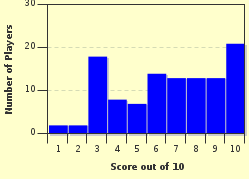Quiz Answer Key and Fun Facts
1. The Tower of Hanoi is a mathematical puzzle that was invented back in 1883 by a French mathematician. Who was he/she?
2. A typical Tower of Hanoi puzzle consists of 3 pegs and 3 circular disks of different sizes stacked nicely on the first peg (the largest disk at the bottom and the smallest one on top). The goal is to move these 3 disks to another empty peg. While moving the disks, can you put a larger disk on a smaller one?
3. A simple Tower of Hanoi puzzle consists of 3 pegs and 3 circular disks. What is the least number of moves that are required to move the disks to another empty peg?
4. Let's say a total of m moves are required to complete a Tower of Hanoi puzzle with 3 pegs and p disks. Now, how many moves are needed to solve the puzzle with (p+1) disks?
5. What is the general formula that is used to calculate the least number of moves required to solve a Tower of Hanoi puzzle with 3 pegs and n disks? (Hint: given that the first few terms of the sequence are 1, 3, 7, 15...)
6. A minimum of 1023 moves are required to solve a Tower of Hanoi puzzle with 3 pegs and 10 disks. Which of the 10 disks will be moved the most (namely 512 times) between the 3 pegs?
7. The solution to which of the following Tower of Hanoi puzzles will require the least moves?
8. The Tower of Hanoi is widely studied in the field of recreational mathematics. Mathematicians have come out with the general formula to calculate the least number of moves required to complete the game. What is the name of the equation that is used to solve this puzzle?
9. The Tower of Hanoi has many useful applications. It is used in which of the following field(s)?
10. The Tower of Hanoi was used as one of the symbols for the 48th International Mathematical Olympiad (IMO) in 2007. Which Southeast Asian country hosted the prestigious event?
Source: Author
Matthew_07
This quiz was reviewed by FunTrivia editor
crisw before going online.
Any errors found in FunTrivia content are routinely corrected through our feedback system.


